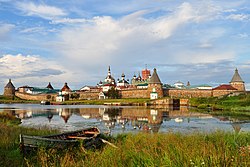Solovetsky Monastery
 |
|
| Monastery information | |
|---|---|
| Order | Russian Orthodox Church |
| Established | 1436 |
| Disestablished | c. 1917 |
| Reestablished | 1990s |
| People | |
| Founder(s) | Zosim of Solovki |
| Important associated figures | German of Solovki, Savvatiy |
| Site | |
| Location | Onega Bay, Solovetsky District, Arkhangelsk Oblast, Russia |
| Coordinates | 65°01′28″N 35°42′38″E / 65.02444°N 35.71056°ECoordinates: 65°01′28″N 35°42′38″E / 65.02444°N 35.71056°E |
| Public access | Yes |
The Solovetsky Monastery (Russian: Солове́цкий монасты́рь; IPA: [səlɐˈvʲɛtskʲɪj mənɐˈstɨrʲ]) is a fortified monastery located on the Solovetsky Islands in the White Sea in northern Russia. It was one of the largest Christian citadels in northern Russia before it was converted into a Soviet prison and labor camp in 1926–39, and served as a prototype for the camps of the Gulag system. The monastery has experienced several major changes and military sieges. Its most important structures date from the 16th century, when Filip Kolychev was its hegumen (comparable to an abbot).
The Solovetsky Monastery was founded in 1436 by the monk Zosima, however, monks German and Savvatiy from the Kirillo-Belozersky Monastery lived on the island from 1429 to 1436, and are considered to be co-founders of the monastery. Zosima later became the first hegumen of the monastery. After Marfa Boretskaya, wife of the posadnik of Novgorod, donated her lands at Kem and Summa to the monastery in 1450, the monastery quickly enlarged its holdings, which was situated strategically on the shores of the White Sea.
...
Wikipedia
